Amazon Prime Student 6-month Trial

Shop Amazon - Create an Amazon Baby Registry

P-47 Thunderbolt: Aviation Darwinism
Chapter Five:
With three Fighter Groups setting up in Britain, the 8th Air Force
hoped to have all three operational by mid February. This would not
be possible due to problems with radios and engine troubles encountered
during high altitude test flights. Many of the Pratt & Whitney engines
were suffering from ignition breakdown and distributor leakage. This
resulted in fouled spark plugs and serious loss of power. These problems
would plague the P-47 for several months. By the end of the Spring of
1943, most of the teething woes will have been overcome.
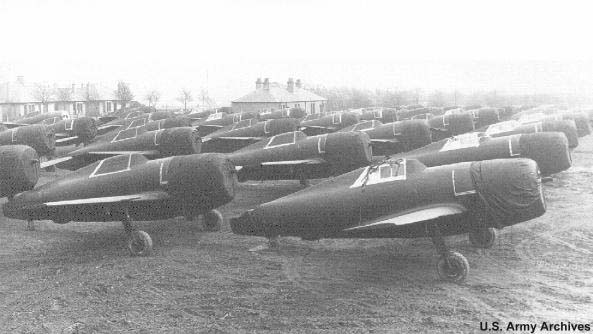 Typically, this is how most P-47's arrived in England. The extent of the
Typically, this is how most P-47's arrived in England. The extent of the
effort required to get these fighters operational can be appreciated.
Finally, on March 10th, the 4th Fighter Group went on operational
status. They fly an offensive fighter sweep over France. 14 Thunderbolts,
accompanied by an even dozen Spitfire Mk.V’s, (still remaining with
the 4th FG) head out to gain some combat experience in their new fighter.
They are ignored by the Luftwaffe. Several of the 4th’s pilots assigned
to the Thunderbolts refuse to fly it. The P-47 is very much disliked by
these veterans of the Eagle Squadron, who prefer their Spitfires. This
first mission does nothing to reduce their unhappiness. Radio communication
was all but impossible due to interference. The attitude of the 4th FG
was not just the result of having to fly a fighter they believed to
be unsuited for aerial combat with the Luftwaffe. Their experience
during work ups was not very positive. Some pilots were forced to bailout
due to fires. Others suffered landing gear collapse on landing. Still
others suffered engine failures. They flew their first combat sweep
with virtually zero confidence in the P-47.
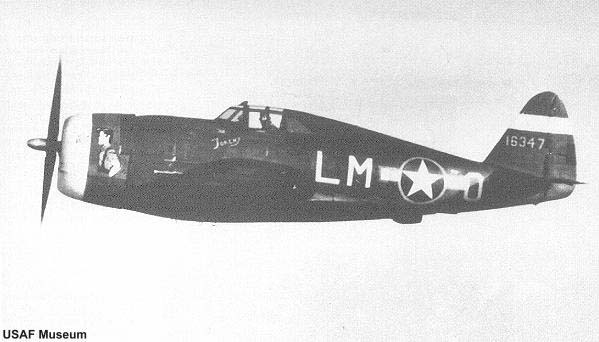 This P-47C-5-RE is piloted by Eugene O'Neill of the 62nd FS, 56th FG.
This P-47C-5-RE is piloted by Eugene O'Neill of the 62nd FS, 56th FG.
Note the Li'l Abner cartoon nose art. This was the typical P-47 flown
by the 4th, 56th and 78th Fighter Groups in the spring and summer of
1943.
This aircraft has been updated in the field to include the new
bulged keel
plumbed for an external drop tank.
What most pilots did not understand was that most of the problems
were a result of the hasty assembly work performed in England. Each
aircraft would need a great deal of attention to iron out the bugs.
Republic technical personnel worked long hours rectifying the problems.
During the first week of April, all three P-47 Groups (4th, 56th and
78th) are formally declared operational. On April 8th, all three
Groups turned out for a joint fighter sweep over France. Once again,
the Luftwaffe ignores their presence. Several more sweeps are flown
during the following days, all uneventful. Finally, on April 15th,
Major Donald Blakeslee, of the 4th FG gets the P-47’s first kill by
shooting down an Fw 190 near Dieppe. Two weeks later, the 56th loses
two Thunderbolts when bounced by Focke Wulfs. They fail to shoot down
any of their attackers. These lost fighters are replaced with the first
P-47D models to arrive in the theater. Externally, the difference
between the early D models and the P-47C is virtually undetectable
to the untrained eye. The single most important difference is that the D models
are equipped with water injection, that provides for greater power when
the throttle is advanced to Combat power.
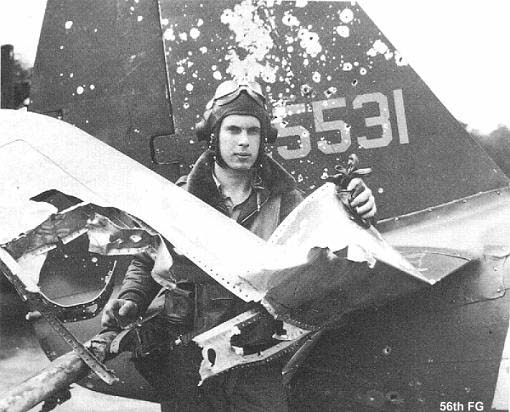 This unknown pilot of the 56th FG managed to nurse this battered
This unknown pilot of the 56th FG managed to nurse this battered
P-47 home after taking a flak hit over Dieppe. It must have taken
great skill to bring home this Thunderbolt.
With the coming of May, escort operations begin. The 78th claims one
German fighter and two probables while escorting heavy bombers to
Antwerp. In exchange, three of the 78th’s P-47’s fail to make it
home. The 56th is doing even worse. After 31 combat missions, they
have yet to claim a single enemy fighter against their several
losses. Eventually, they score their first victory during a sweep
over Rouen on June 12th. On the very next day, Robert Johnson got
his first kill, blasting an Fw 190 to pieces. However, on June 26th,
the 56th lost five Thunderbolts with four more shot to pieces. All
they can claim is two German fighters.
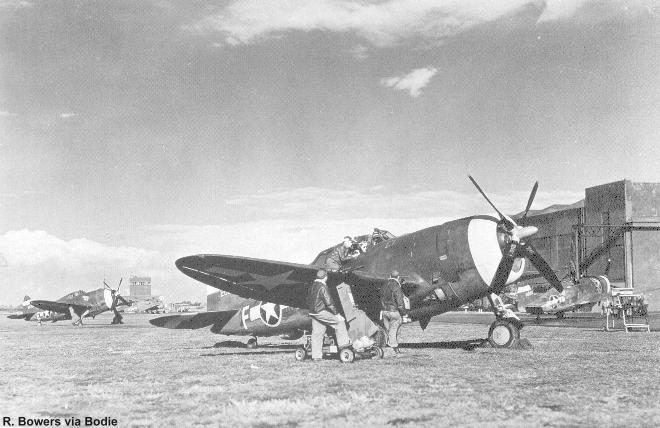 Several P-47D-2-RE fighters on a British airfield, circa July 1943.
Not uncommon
Several P-47D-2-RE fighters on a British airfield, circa July 1943.
Not uncommon
at the time, many P-47's operated off of unpaved sod fields.
It was on this mission that Johnson’s P-47 is crippled by enemy fire.
Refusing to break formation (after being chewed out for doing just
that when he gained his first victory) Johnson repeatedly tried to
warn his Group of attacking Fw 190’s. For some reason, no one heard
his frantic radio calls. Johnson’s fighter was clobbered by German
20mm cannon shells. The engine was hit, the hydraulic system shot
out, spraying Johnson with fluid. His canopy was jammed closed and
his oxygen system destroyed. The leaking hydraulic fluid and oxygen
came in contact with each other and burst into flame inside the cockpit. Fortunately,
it was only a flash fire, but Johnson was properly singed, losing his
eyebrows and taking on the appearance of a cooked lobster. Having flown
without his goggles (they were being repaired), the mist of hydraulic
fluid nearly blinded him and caused swelling that threatened to eliminate
what limited vision he retained.
Without oxygen, hypoxia began to cloud Johnson’s reasoning. In a
panic, he fought to get out of the wrecked P-47. The canopy would
not slide back more than a few inches. Jamming his feet against the
shot up instrument panel, he pulled with all his considerable strength.
No luck, it would not budge. One of the side plexiglass panels had been
blown out of the canopy. Johnson tried to squeeze through it, but his
parachute snagged. No sense in climbing out unless he brings his chute
with him. What to do?
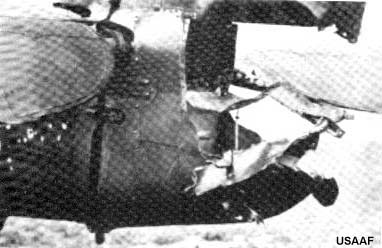 This well known photo shows the bottom portion of Johnson's
This well known photo shows the bottom portion of Johnson's
rudder having been blasted away by 20 mm cannon shells.
While Johnson was struggling with his situation, the P-47 was rapidly
descending. As he lost altitude, the effects of hypoxia were wearing
off and the cobwebs began to dissipate. Quite suddenly, it dawned on
him that the Thunderbolt was actually flying. Upon this realization,
Johnson decided to see how far he could nurse it towards the English
channel. He eased off the throttle and the Pratt & Whitney radial stopped its
shaking. The big fighter answered its controls with authority.
Johnson was elated. Maybe, just maybe, he could make it home.
Then he saw it. Sliding in from his left rear, a fighter closes in.
But, whose fighter? Then, he recognized it. A beautiful but deadly
Fw-190 with a gleaming yellow nose. Flying just off Johnson's wing, the
German pilot scans the shot
up P-47. Wondering what is going through the German pilot's mind,
Johnson watches as he eases away and swings around in a graceful turn;
sliding in behind the Thunderbolt. Knowing full well what’s to come,
Johnson grabs the seat adjuster lever and drops the seat full down
where he is afforded the full protection of the armor plate behind
the seat. Johnson thinks to himself; “let him shoot, this Thunderbolt
can’t be hurt anymore than it already is.” The Fw 190 opens up on the
flying wreck. Like hail on a tin roof, 7.92 mm rounds pour into the
Jug. What, no 20 mm? Thankfully, these have all been expended in some
other fight. Johnson sits, hunkered down behind the armor as the
German pilot ripsaws the battered Thunderbolt with hundreds of
rounds.
Finally, his anger building, Johnson decides that he must do something.
Kicking hard right and left rudder, the big fighter yaws right, then
left. This scrubs off speed and caught off guard, the German cannot
avoid over-running the P-47. Johnson sees him go by, but is unable to
see anything through his oil covered windscreen. Shoving his head out
through the shattered canopy, Johnson sees the Fw 190 turn gently to
the right. Seeing an opportunity, he kicks hard right rudder, skidding
the Thunderbolt, Johnson depresses the gun switch button. A stream of
tracers heads towards the German fighter. But, it doesn’t falter.
Instead, it continues around in a perfect turn and slides in alongside
the perforated P-47 once again. Johnson makes eye contact with the
German pilot. He can see the dismay on the German’s face. There is no
way that this American fighter can still be flying. It is impossible
that it could absorb such a pounding and keep on flying. The Focke
Wulf eases out to the right, and slides back into perfect firing
position once again. Johnson cowers behind his armor plate as 7.92
mm bullets rain upon the utterly mangled Thunderbolt. Just when
Johnson is convinced that it will never stop, he stamps down hard on
the rudder pedals again. This time the German expects just such a
move and pulls off his throttle. The dappled 190 eases up on Johnson’s
wing once again, the German pilot shaking his head in silent amazement.
They fly this way for several minutes. Finally, the German waves an
informal salute and slides in behind Johnson’s invulnerable fighter
for the third time. As before, the Jug is pounded by streams of lead. The
Fw 190 swings gently from left to right, spraying the indestructible
P-47 with an incessant barrage of machine gun fire. Suddenly, it
stops. The Focke Wulf eases alongside again. The German looks over
the Thunderbolt. The pilot stares with a look of admiration on his
face. Pulling even with Johnson, the 190 wags its wings in salute
and peels away in a climbing turn. Having fired his last rounds at
the stubborn Jug, the German heads for home, certainly convinced
that the mauled fighter will never make home.
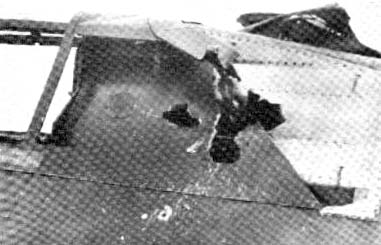 Another well known photo showing the damage to Johnson's canopy
Another well known photo showing the damage to Johnson's canopy
that caused it to jam. The large holes are from 20 mm cannon hits. The
smaller holes are mostly
from 7.92 mm bullets.
Finally free of the Focke Wulf, Johnson suddenly realizes that during
the entire attack, he had depressed his mike button. Releasing the
button, the accented voice of an Englishman fills his headphones.
“Hello, hello, climb if you can, you’re getting very faint”. It was
Air-Sea Rescue. They had heard the entire fight, including Johnson
cursing his tormentor. Johnson’s spirit soars, and he responds,
“I’ll try, but I’m down to less than 1,000 feet”. Shouting with joy,
he eases back on the stick. Not only will the Thunderbolt fly, hot
damn, She’ll climb! Slowly, Johnson nurses the P-47 up to 8,000 feet.
The big fighter hauls herself up, instilling greater confidence in a
man who was ready to bail out but a few minutes before. “Blue four,
blue four, I have you loud and clear. Steer three-four–five degrees.”
“I can’t do that mayday control, my compass is shot out” answers Johnson.
The calm British voice issues instructions to “turn slightly right”,
and continues to provide course corrections until, after 40 minutes
Johnson spots the coast of Dover through broken clouds. Directed to
an emergency airfield, Johnson circles but cannot spot the sod runway.
After checking his fuel, he pushes the mike button;
“Mayday control, this is blue four, I’m ok now. I’m going to fly onto
Manston. I’d like to land back at my outfit.”
Johnson continues on to Manston. Contacting the tower, he describes
his situation. The last test comes as he moves the landing gear lever
to the “down” position. Not only does the gear drop and lock, but by
some miracle, the tires have not been hit. Easing onto the grass,
Johnson has no flaps and no brakes. The big fighter does not slow and
is heading towards a row of RAF Spitfires and Typhoons parked at the
end of the runway. In desperation, he stomps on the left rudder
pedal. The Thunderbolt ground loops and slides backwards in between
two of the British fighters just like it had been parked there.
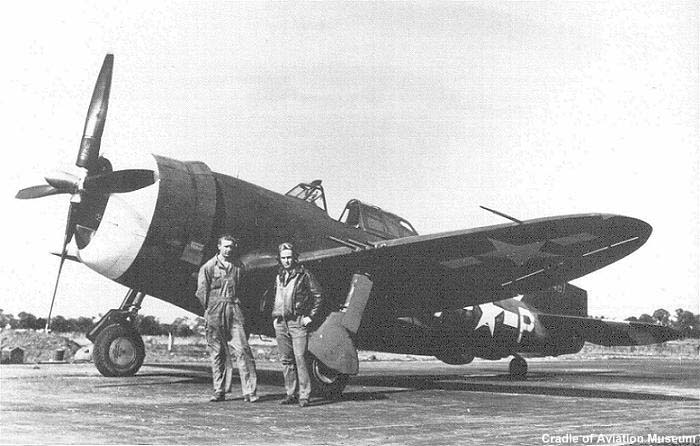 Robert Johnson and his crew chief, Pappy Gould, pose in front his new
Robert Johnson and his crew chief, Pappy Gould, pose in front his new
P-47D-5-RE. This fighter was the replacement for his battered and
scrapped P-47C. Johnson would name the new fighter "Lucky".
Slowly, Johnson gathers his wits and removing his parachute, squeezes
out of the shattered canopy. Once on the ground he realizes the extent
of the damage. Not only to the plane, but to himself. A bullet had nicked
his nose. His hands were bleeding from the shrapnel of 20 mm shells
that exploded in the cockpit. Two 7.92 mm rounds had hit him in his
leg. 21 holes from 20 mm shells are counted in the airframe. He quits
counting bullet holes when he reaches 100. It seems as if every square
foot of the fighter has a hole in it. Somehow, the P-47 had shrugged
off the damage and refused to die. Johnson will recover quickly.
The Thunderbolt will not. It was scrapped on the spot, very little
could be salvaged that was not damaged.
Robert Johnson would go on to shoot down 28 (revised down to 27 after
the war) German fighters, with 6 probables and 4 more damaged. After
the war, Luftwaffe records indicated that Johnson might have shot
down as many as 32 German fighters. Johnson flew 91 combat missions. On those
missions, he encountered German fighters 43 times. In 36 of the 43 encounters,
Johnson fired his guns at the enemy. A result of those 36 instances where
he fired on German aircraft, 37 of those aircraft were hit; with as few as
27 or as many as 32 going down. Rather impressive for a pilot who flunked
gunnery school.
Events were really beginning to speed up in the ETO. Yet, on the other
side of the world, the P-47 was about to enter service against the Japanese.
How successful would the massive Thunderbolt be against the lightweight and agile fighters
of the Japanese Army Air Force and the much vaunted Zero of the Imperial
Japanese Navy?
Go to Chapter Six
Return to the Planes and Pilots of WWII
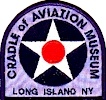 Return to the Cradle of Aviation Museum
Return to the Cradle of Aviation Museum

Unless otherwise indicated, all articles Copyright © Jordan Publishing Inc. 1998/1999.
Reproduction for distribution, or posting to a public forum without express written
permission is a violation of applicable copyright law. The Cradle of Aviation
Museum patch is the property of the Cradle of Aviation Museum.
Reproduction for distribution, or
posting to a public forum without the written permission
of
Jordan Publishing Inc. is prohibited.












